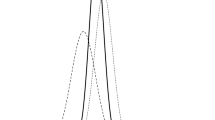Summary
The procedure of maximizing the missing information is applied to derive reference posterior probabilities for null hypotheses. The results shed further light on Lindley’s paradox and suggest that a Bayesian interpretation of classical hypothesis testing is possible by providing a one-to-one approximate relationship between significance levels and posterior probabilities.
Similar content being viewed by others
References
Bartlett, M.S. (1957). A comment on D. v. Lindley’s statistical paradox.Biometrika 44, 533–534.
Bernardo, J.M. (1979a). Expected information as expected utility.Ann. Statist. 7, 686–690.
— (1979b). Reference posterior distributions for Bayesian inference.J. Roy. Statist. Soc. B 41, 113–147 (with discussion).
Demster, A.P. (1971). Model searching and estimation in the logic of inference. InFoundations of Statistical Inference (Godambe, V.P. and Sprott, D.A. eds.), 56–81. Toronto: Holt, Rinehart and Winston.
Good, I.J. (1966). A derivation of the probabilistic explication of information.J. Roy. Statist. Soc. B 28, 578–581.
Ibragimov, I.A. andHasminsky, R.Z. (1973). On the information in a sample about a parameter.2nd Internat. Symp. Information Theory. (Petrov and Csaki eds.) 295–309. Budapest: Akedemiai Kiado.
Jeffreys, H. (1939/67).Theory of probability. Oxford: Clarendon Press.
Lindley, D.V. (1956). On a measure of the information provided by an experiment.Ann. Math. 27, 986–1005.
— (1957). A statistical paradox.Biometrika 44, 187–192.
POPPER, K.R. (1958).The logic of scientific discovery. London: Hutchinson and Co.
SHANNON, C.E. (1948). A mathematical theory of communication.Bell System Tech. J. 27, 379–423, 623–656.
SOAL, S.G. and BATEMAN, F. (1954).Modern Experiments in Telepathy. London: Faber and Faber.
STONE, M. (1958).Studies with a measure of information. Ph. D. Thesis, University of Cambridge.
References in the Discussion
AKAIKE, H. (1978). A Bayesian analysis of the minimum AIC procedure.Ann. Inst. Statist. Math. 30, 9–14.
ATKINSON, A.C. (1978). Posterior probabilities for choosing a regression model.Biometrika 65, 39–48.
COCCONI, G. and SALPETER, E.E. (1958).Nuovo Cimento 10, 646.
COX, R.T. (1946).Amer. J. Phys. 14, 1–13.
— (1961).The Algebra of Probable Inference. Baltimore: John Hopkins.
— (1978). Of inference and inquiry. InThe Maximum-Entropy Formalism. (Levine, R.D. & Tribus, M. eds.) 119–167. Cambridge, Mass.: M.I.T. Press.
DEMPSTER, A.P. (1973). The direct use of likelihood for significance testing.Proceedings of the Conference on Foundational Questions in Statistical Inference. (Barndorff-Nielsen, O., Blaesild, P. and Schou, G., eds.) 335–352. University of Aarhus.
DICKEY, J.M. (1971). The weighted, likelihood ratio, linear hypotheses on normal location parameters.Ann. Math. Statist. 42, 204–223.
— (1978). Approximate coherence for regression model inference with a new analysis of Fisher’s Broadbalk Wheatfield example.Bayesian Analysis in Econometric and Statistics: Essays in Honor of Harold Jeffreys (Zellner, A. ed.) 333–354. Amsterdam: North-Holland.
GEISSER, S. (1980). The contributions of Sir Harold Jeffreys to Bayesian Inference. InBayesian Analysis in Econometrics and Statistics: Essays in Honor of Harold Jeffreys. (Zellner, A., ed.) 13–20. Amsterdam: North Holland.
GEISSER, S. and EDDY, W.F. (1979). A predictive approach to model selection.J. Amer. Statist. Assoc. 74, 153–160.
GOOD, I.J. (1950).Probability and the Weighing of Evidence. New York: Haffners.
— (1957). Saddle-point methods for the multinomial distribution.Ann. Math. Statist. 28, 861–880.
— (1969). What is the use of a distribution? InMultivariate Analysis II. (Krishaiah, P.R., ed.) 183–203. New York: Academic Press.
GOOD, I.J. and CROOK, J.F. (1974). The Bayes/Non Bayes compromise and the multinomial distribution.J. Amer. Statist. Assoc. 69. 711–720.
JAYNES, E.T. (1976). Confidence intervals vs. Bayesian intervals (with discussion). InFoundations of Probability Theory, Statistical Inference, and Statistical Theories of Science. (Harper, W.L. & Hooker, C.A., eds.) 175–257. Dordrecht, Holland: D. Reidel.
— (1979). Marginalization and prior probabilities (with discussion). InBayesian Analysis in Econometrics and Statistics: Essays in Honor of Harold Jeffreys. (Zellner, A., ed.) 43–87. Amsterdam: North-Holland.
JEFFREYS, H. (1963). Review of L.J. Savage, et. al.The Foundations of Statistical Inference, (1962).Technometrics 5, 407–410.
— (1967).Theory of Probability. (3rdrev.ed.). Oxford: University Press.
JEFFREYS, H. (1979). Personal communication.
KLEIN, F. (1939).The Monist 39, 350–364.
LINDLEY, D.V. (1957). A statistical paradox.Biometrika 44, 187–192.
— (1961). The use of prior probability distributions in statistical inference and decision.Proc. 4th. Berkeley Symposium 1, 453–468.
— (1965).Introduction to Probability and Statistics from a Bayesian Viewpoint: Part 2, Inference. Cambridge: University Press.
MOLINA, E.C. (1963). Some comments on Bayes’ Essay. InTwo Papers by Bayes (Deming, W.E., ed.) 7–12. New York: Hafner Pub. Co.
PEARSON, E.S. (1962). Some thoughts on statistical inference.Ann. Math. Statist. 33, 394–403.
SAVAGE, L.J. (1962).The Foundations of Statistical Inference: A Discussion. London: Methuen.
SCHWARZ, G. (1978). Estimating the dimension of a model.Ann. Statist. 6, 461–464.
SHERWIN, C.W.,et al. (1960).Phys. Rev. Lett. 4, 399–400.
SMITH, A.F.M. and SPIEGELHALTER, D.J. (1980). Bayes factors and choice criteria for linear models.J. Roy. Statist. Soc. B. 42, 213–220.
WEISSKOPF, V.F. (1961). Selected topics in theoretical physics. InLectures in Theoretical Physics,3, 54–105. (Brittin, W.,et al. eds.) New York: Interscience Publishers, Inc.
ZELLNER, A. (1971).An Introduction to Bayesian Inference in Econometrics. New York: Wiley.
— (1977). Maximal data information prior distributions. InNew Developments in the Applications of Bayesian Methods. (Aykac, A. and Brumat, C., eds.) Ch. 12, 211–232. Amsterdam: North-Holland.
ZELLNER, A. and SIOW, A. (1979). On posterior odds ratios for sharp null hypotheses and one-sided alternatives.Tech. Rep. University of Chicago.
Author information
Authors and Affiliations
Rights and permissions
About this article
Cite this article
Bernardo, J.M. A Bayesian analysis of classical hypothesis testing. Trabajos de Estadistica Y de Investigacion Operativa 31, 605–647 (1980). https://doi.org/10.1007/BF02888370
Issue Date:
DOI: https://doi.org/10.1007/BF02888370




